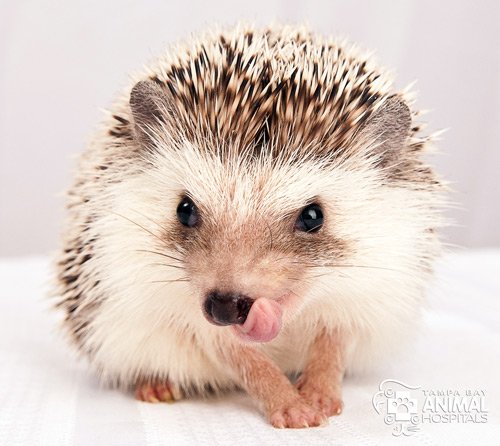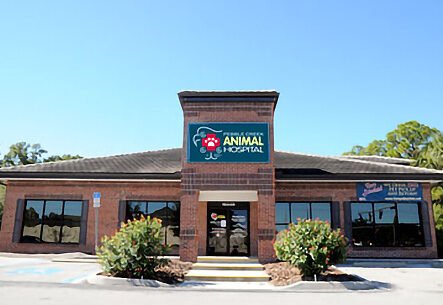Hedgehogs

What to expect from your Hedgehog
Hedgehogs are noiseless, odorless, inoffensive and nondestructive in their manner. They are nocturnal and therefore are active in the evenings. If they are allowed to run in the house, they tend to hide in corners or under furniture. Many hedgehogs dig in carpets or in houseplant dirt, if accessible, and will forage for spiders and insects in the home. Most hedgehogs prefer dim, quiet environments and may react with fright at loud noises or bright lights. Hedgehogs are solitary by nature. When encountering something new in the environment a hedgehog may “taste” it, then begin hypersalivating and create a foam, which it then spits onto itself. The process is called “anting” or “anointing.” Most owners will promptly rinse or bathe the hedgehog to get rid of the material.
Vital statistics
- Body length: 7 inches (17 cm)
- Body weight: male African: 500-600 g, female African: 250-400 g, male European: 800-1200 g, female European: 400-800 g
- Sexual maturity: 3 months
- Maximum life span: 4-7 years
What should you feed your Hedgehog?
The hedgehog diet is omnivorous, high in protein and low in fat. High fat foods adversely affect the hedgehog’s health and longevity. To minimize obesity, ad lib feeding of adults should be discouraged. One should feed in the evening a portion size that is almost completely consumed by morning. Only a small amount of food needs to be present during the day for a snack.
A sample diet for an adult hedgehog for one day is: 2-3 tablespoons dry (or mixture of dry and canned) reduced-calorie cat food; 1-2 tablespoons mixed fresh vegetables and 3-5 insects 3-4 times a week. Invertebrates are important to the diet, especially for breeding sows, and may include mealworms, worms, insects and crickets.
Commercial complete hedgehog diets are being developed and should be used if available. To introduce individuals to new diets, mix new foods gradually into the old. It helps to have all chunks or pieces of the new and old diets the same size and relative consistency.
Is your Hedgehog a male or a female?
Males have a midventral penis and abdominal testicles.
What do Hedgehogs do all day?
Hedgehogs need liberal exercise and are competent climbers. Logs can be arranged in the enclosure to form caves, tunnels and arches. They will use exercise wheels but do not “play” with toys. When at ease and during warm weather, hedgehogs like to sleep in a half-ball position or completely flat, legs outstretched.
Are Hedgehogs tame?
Although the African pygmy hedgehog is being commercially bred and raised, it is essentially non-domesticated and is an extremely timid and nervous animal. Young hedgehogs do not mind being held, but many adults, especially males, struggle to be let loose. Their first defense is to roll up into a tight ball of crisscrossed spines, with the head and legs in the center of the ball. Hedgehogs are not aggressive, but they may bite if provoked. Adults also vocalize with a hissing sound when bothered. Some hedgehogs will uncurl with back stroking of rump spines, a quiet environment and subdued lighting.
How to keep your Hedgehog healthy, happy and safe
- Feed once a day in the late afternoon or early evening, preferably in heavy crocks.
- Fresh water must be available at all times, offered either from a sipper bottle or crock.
- Prevent obesity. Ad lib feeding may not be appropriate. Weigh hedgehog at least monthly.
- Take your hedgehog to an exotic animal veterinarian for an annual physical examination.
- Routinely brush its teeth and provide veterinary scaling.
- Prevent chilling; provide heated environment with dry bedding.
- Clean toys frequently.
- Handle a tame hedgehog every day to keep it tame.
Housing for your African pygmy hedgehog should:
- be a smooth-walled enclosure that is high enough to prevent escape. Aquariums 20 gallon or larger are acceptable
- contain newspaper or recycled material bedding to a depth of several inches and should be changed frequently and kept dry
- be maintained in the optimum environmental temperature range of 75-85 F
- include accessories for climbing/hiding: box, untreated fruit tree log or flower pot
- contain a pan or shallow tub (warm water, warm ambient temperature) for swimming
- offer smooth clean rocks for spreading out on, gnawing, scratching and as face-rubbing surfaces
It is important to prevent hedgehogs from accessing:
- wire flooring in its enclosure
- wire rodent exercise wheels
- cat or dog food as sole diet
- sawdust, pine or cedar shavings
- wet bedding
- garden soil (may contain parasites)
- dogs, cats and young children
- pesticides and other toxins
- electrical cords
- tobacco and cigarette smoke
- toxic houseplants
What your veterinarian looks for in a healthy Hedgehog
- Clear, bright eyes (no discharge)
- Mouth free of discharge
- Nails of appropriate length
- Firm, lean body
- Body free of lumps and bumps
Most common disorders of African Pygmy Hedgehogs
- Obesity
- Dermatitis/mange mites
- Pneumonia
- Tumors (especially over 3 years of age)
- Enteritis
- Fatty liver
- Dental problems
- Potential carrier of Salmonella
- Internal parasites
Many common disease conditions in hedgehogs are the result of malnutrition. Visiting your exotic animal veterinarian for routine health checks will help prevent many diseases and support you in having a long, satisfying relationship with your hedgehog.
Background information
Hedgehogs are indigenous to Europe, Africa and Asia. Two distinct hedgehog species are available to the pet trade: the African or white-bellied hedgehog, which is the most common in the United States, and the European hedgehog. Free-ranging hedgehogs are hardy animals that live in scrub, deciduous forests, rocky grasslands and deserts. Hedgehogs eat very little plant matter, preferring instead insects, spiders, slugs, snails, worms and grubs. They nest under shrubs and rocks or in burrows. Their sense of smell is highly developed. The body and crown of hedgehogs are covered in short, smooth spines while their underside is soft white fur. The spines of young hedgehogs are sharper than those of mature animals. To reduce the potential risk of Salmonella infection, clients should wash their hands after handling a pet hedgehog and avoid the animal’s contact with human food or cooking utensils.
Courtesy of Zoological Education Network
Tampa, FL 33615 (View map)
Tampa, FL 33647 (View map)
Tampa, FL 33617 (View map)
Tampa, FL 33647 (View map)








